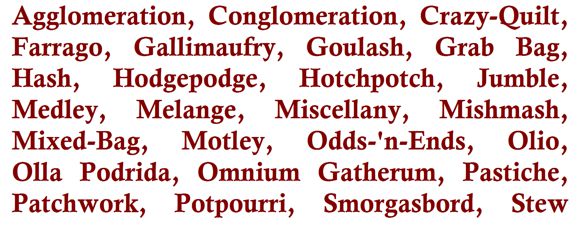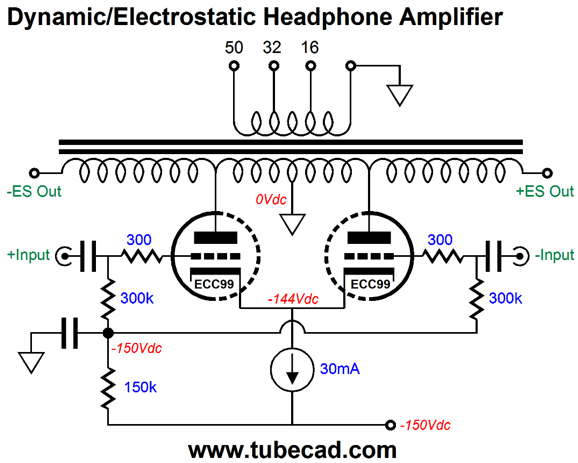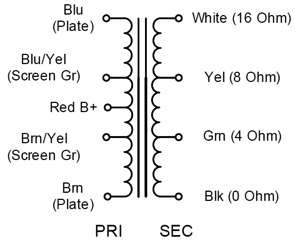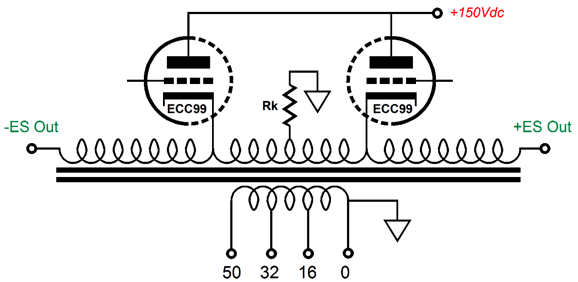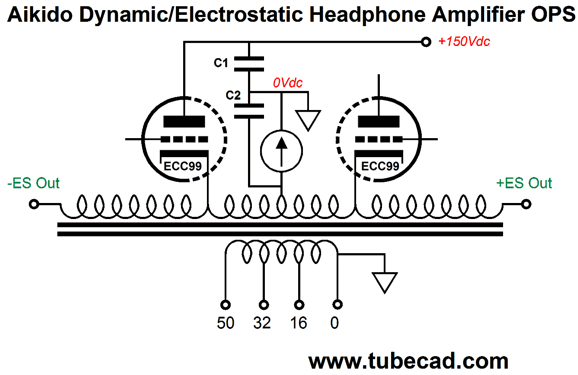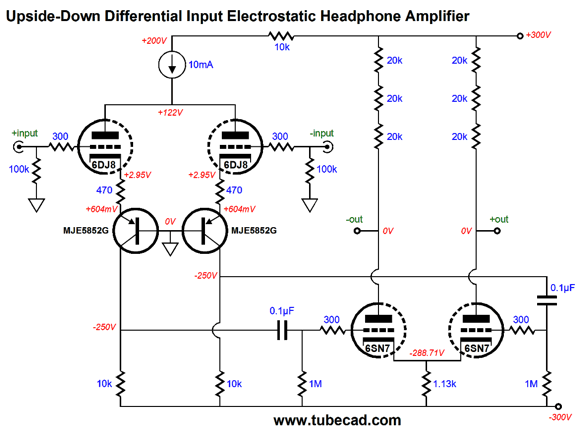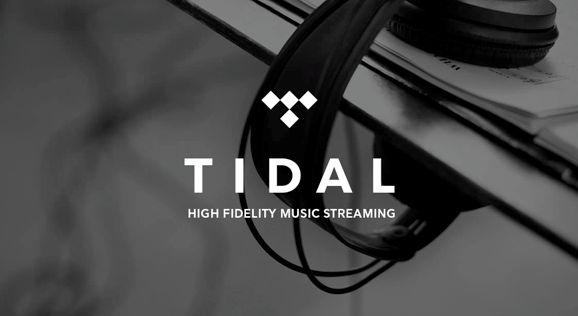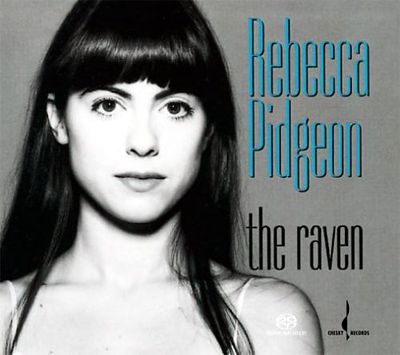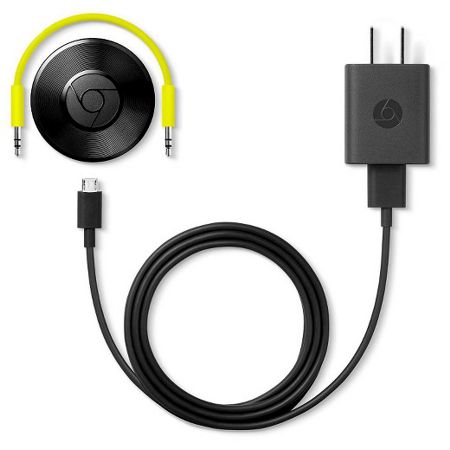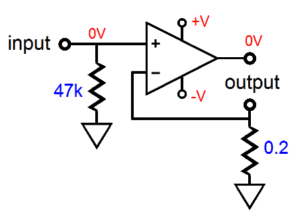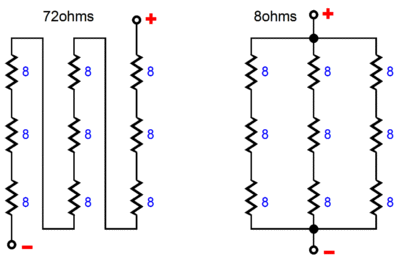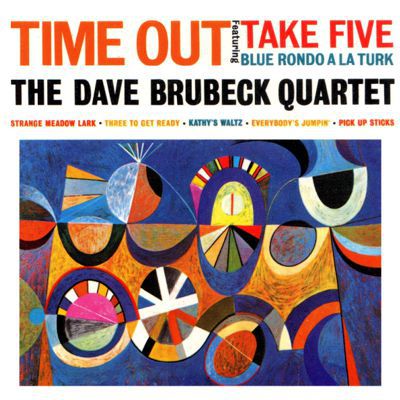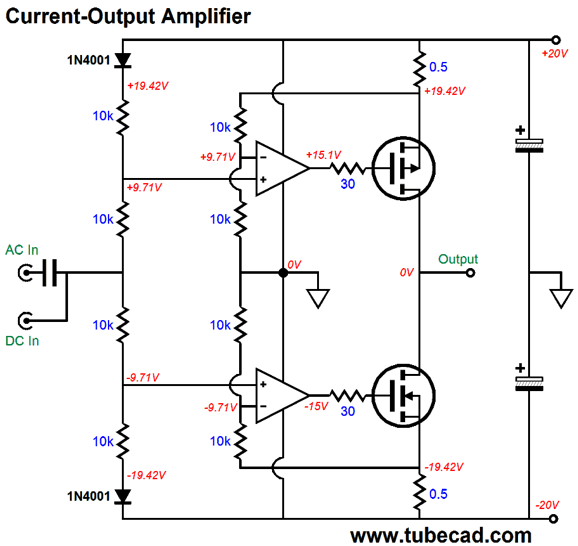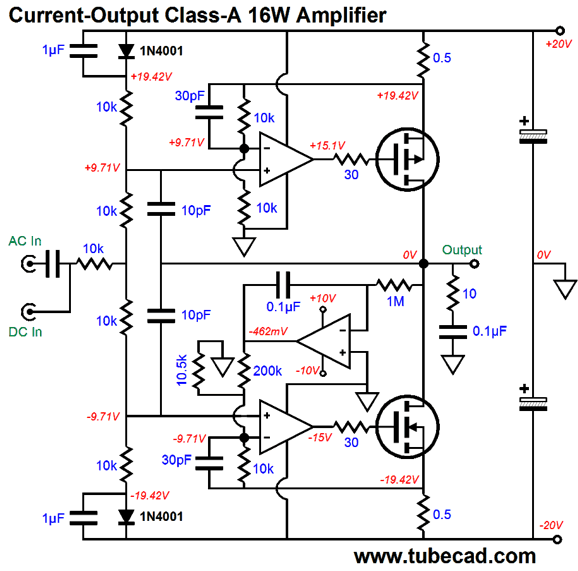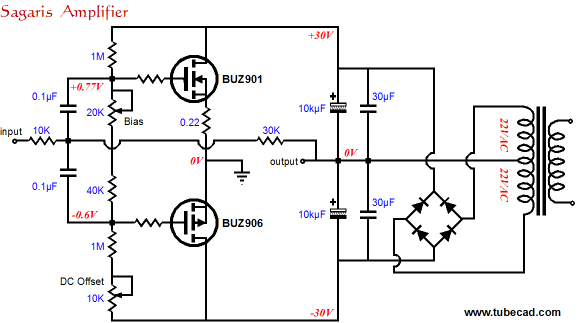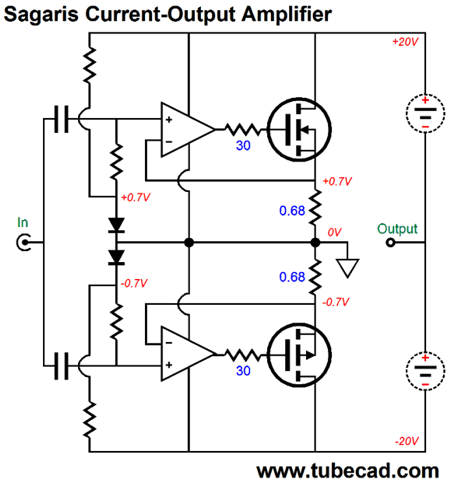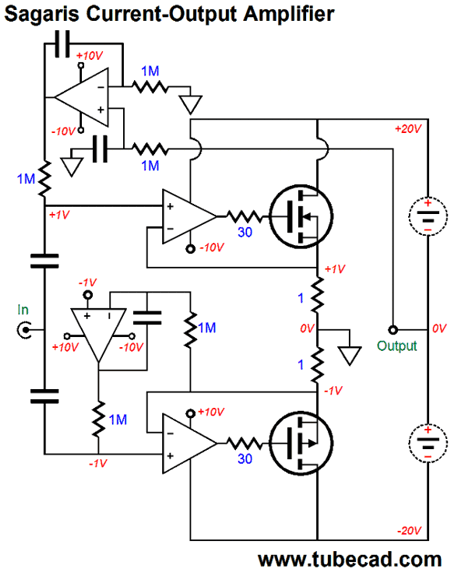| John Broskie's Guide to Tube Circuit Analysis & Design |
|
11 June 2017 Post 383
Miscellany etc.
More Electrostatic Headphone Amplifiers One item I failed to mention last time was that electrostatic headphone amplifiers do not have to be OTL in design, as transformer coupling is certainly an option. One thought I have had is that a dual-use headphone amplifier would come in handy, an amplifier that could drive either dynamic or electrostatic headphones. The following schematic shows an ultra-linear output transformer being used with a pair of output triodes and a negative power-supply rail.
The two triodes attach to the ultra-linear taps, so the primary's ends see a far greater voltage swing than the triode plates undergo. If we assume a 40% ultra-linear ratio, then a 40V plate swing will result in a 100V stator voltage swing. The negative power-supply rail is critical, as we want the electrostatic headphone's stators to be at ground potential. The two output triode share a common constant-current source, which shields the triodes from the negative power-supply noise and auto-biases the triodes. A balanced pair of input signals is required to drive the triodes. The added film capacitor helps buffer the input signals from the negative power-supply rail ripple. The output transformer secondary offers three impedance taps: 50, 32, and 16 ohms. The interesting question is, What is the reflected impedance to the triode plates? Let use the Hammond Manufacturing 1608A output transformer as an example. (I often mention Hammond products here; I do not have any association with the company, however. Indeed, I have quite mixed emotions regarding its products.)
The 1608A is a 10W & 8k ultra-linear output transformer with ultra-linear taps at 40% of the primary. First we must find the winding ratio, which is equal to the square root of the impedance ratio. Thus, given that 8,000/8 equals 1,000:1, the winding ratio equals the square root of 1,000 or 31.6; 40% of which is 12.65. Since the impedance ratio equals the winding ratio squared, we multiply 32 ohms by 160 and get 5,120 ohms as the plate-to-plate impedance that the triodes see. In other words, a 32-ohm Grado headphone driver will reflect as 5,120 ohms to the output tubes. What about 16-ohm ear-buds? The same impedance results. What about 50-ohm headphones, such as many planar types and the Sennheiser HD 558? Ah, here the math gets a tad more difficult. If we had attached 64-ohm headphones, then the same 5,120 –ohm impedance would result, as the impedance ratio for the nominally 16-ohm tap to the ultra-linear taps was 64/5,120 or 1:80. But 50 ohms against 80 equals 4,000 ohms. Is this a big deal? No, not really. If you are the nervous type, then a 14-ohm resistor could be placed in series with the "16-ohm" tap. How big a voltage swing can we expect into 32-ohm headphones? Well, the constant-current source sets the maximum current flow into the primary to 30mA and 30mA against half of 5,120 ohms equals 76.8V, which divided by the winding ratio of 12.65 equals 6Vpk, which in turn equals 0.56W. Not bad. 6Vpk is ear-bleeding loud. Another approach is to use a cathode follower arrangement, as shown below.
This output stage will require huge input voltage swings to the drive the grids, but it will result in a vastly lower output impedance and distortion. Note that we used a positive power-supply rail voltage this time, as we still want the stators to see a near ground voltage potential. Also note how the constant-current source was replaced by a shared cathode resistor. A constant-current source, however, could be used instead. Indeed, we can apply some Aikido mojo here.
Capacitor C1 must be 1/mu as big in value as capacitor C2. In the case of the JJ ECC99, 1/22 as big; for example, 4.7µF and 100µF would be close enough. As for the electrostatic outputs, the cathode-follower operation will provide the lower output impedance that the electrostatic headphones will prefer. Mind you, with electrostatic speakers and headphones, a low Zo is not enough, as current will be needed to charge and discharge the load capacitance. Check out tubecad.com/november99/page3 for the formulas for slew-rate and current and capacitance. The mistake many make, however, is to assume that you need full-power bandwidth out to 20kHz. You don't. Indeed, almost all the big famous electrostatic loudspeakers would seem to fail this requirement, yet sound quite good. Music does not hold an equal spread of power requirement across frequencies. I have measured my Stax headphones and the capacitance stator-to-stator was only 170pF. Long ago, I needed a long extension cord, so I could listen to the ES headphones while sitting 15 feet away from my ES HP amplifier. I used the lowest capacitance five-conductor cable I could find and the extension cable's capacitance nonetheless far exceeded the headphones. Yet, the sound wasn't bad with the added cable. In fact, the cable inserted a soft roll off of high frequencies that I liked with certain recordings, say 1970s Deutsche Grammophon classical LPs. So, I often used the extension cable as a tone control, even when I sat next to my electrostatic headphone amplifier. Look at the following circuit and guess the plate-to-plate output impedance.
Did you guess 120k? Or 30k? The correct answer is 7k, which into the 170pF load capacitance equals a -3dB down frequency of 134kHz. Not bad. About 30 years ago, I built a pentode-based ES HPA that I thought would rule the world. It didn't, sad to say. Its differential Zo was about 60kohm. (If you want an even lower Zo, use a JJ ECC99 instead of the 6SN7.)
Tidal and Digital Downloads Indeed, I would like to create a personal homepage, which would only hold links to blues, jazz, retro, rock, world, and classical music. Classical music, in particular, is a genre that most music players and services just don't understand. Tidal is no different in this regard, as it is song centric, not composition centric; it features performing artists, not composers; it has no idea what of what an opus number or allegro, andante, and largo mean. In the near future, I predict that Tidal will face competition from classical-music-only streaming subscription services that are tailored for Beethoven lovers. Perhaps, now that Jay Z has sold his interest in Tidal, the company will spin off its own jazz and classical centric subdivisions. Still, I believe that Tidal offers enough musical satisfaction to justify the $19 a month I pay them. I especially like being able to follow the suggested artists links that Tidal shows while playing an album. For example, most audiophiles know Rebecca Pidgeon's CD, the raven. One such suggested artist was Joyce Breach, whom I ended up quite liking. In addition, I enjoying dropping into the new jazz and classical albums on Tidal. Some fall into the category of Albums-I-Enjoyed-Hearing-Once, such as Rufus Wainwright's CD, Take All My Loves: 9 Shakespeare Sonnets. Much like a good comedy routine, hearing this album once was fun and sufficient.
Recently, I discovered that ECM had released a new Arvo Pärt CD, The Deer's Cry. I love Pärt's music ever since I discovered it back in 1989. If you don't know his music, you are missing something special. I like the description that Dr. Hermann Conen of ECM Records made of it:
Dang right. I once met a fellow Pärt lover, who told me an interesting story. Arvo Pärt had been invited to the Cabrillo Composers Workshop and she instantly fell in love with his music, so much so that she invited the great man to her house for lunch. She told me that her kids were feral (her own description) and she hoped that they would behave. Pärt arrived and her wild kids instantly grew calm and courteous. The lunch went well and after he left, her kids resumed their untamed state.
Well, I was about to give Amazon close to $20 to buy the CD (including shipping), when I wondered if I couldn't just buy a loss-less download instead. Tidal does sell FLAC downloadable CD albums, but they didn't offer this one. I went hunting and I found it at prestoclassical.co.uk a Britt website that I had read about in the Britt audio press. Only $13 later, I was listening to the new Arvo Pärt album. Dang fine. Buy it and feed your soul.
Chromecast Audio I was wrong. I then read the instructions. The default setting is for reduced dynamic range on the audio out, but not on the digital out. I fired up the Android Chromecast app and flipped the setting to uncompressed-sound and my ears are much happier now, as the audio out is better than the Duet's audio output. I use the Plex app to play music off my computer's hard drive. This app is just okay. For most folks, those with music collections no bigger than a few dozen CDs, it is dang near perfect. For those with huge collections, however, it stinks. But then, all music programs stink in their own way. Once again, the big problem is taxonomy. None of them understands how classical music differs from Taylor Swift's latest hit. In fact, these programs often assume that each movement with in a symphony is a discrete song. ( I actually have the wherewithal [knowledge and compilers] to create an Android [or iPhone] app that would better deal with my music collection. If only I had the time.) In short, buy one—or two. (The price goes up back to $35 each June 18th.) By the way, this little disk runs hot. I have read that replacing the stock switcher 5V PS with a good linear regulated PS makes a big improvement. I haven't tried this yet, as it uses one of those mini USB power connectors. I actually sell a power-supply kit that holds two low-voltage regulated outputs and one high-voltage unregulated although RC-filtered output, the PS-15. With this power supply, the Chromecast Audio would get 5Vdc of linear regulated juice, while the tube circuit would get 12Vdc. The punch line here is that we could incorporate a Chromecast Audio within our next audio project. Imagine a tube-based headphone amplifier with a built-in WiFi audio streaming capability. Nice.
Current-Out Amplifier One advantage a current-out amplifier would overcome a big problem with conventional speakers: heat. Ever notice that a horn-loaded speaker, no matter how non-flat its output, still offers a huge advantage over conventional speaker: namely, robust dynamics. Horn tweeters in particular play back plucked string instrument recordings in an alive fashion, which no dome tweeter can match, as the domes always sound as though they were made of soft felt. I believe that it was KEF that did the initial research into heat and voicecoil impedance rise. Think about it: if a speaker driver is grossly inefficient, which just about all non-horn speaker drivers are, then the vast amount of energy delivered to the driver must turn into heat, since it wasn't turned into sound. Is this a problem? Yes, it is, as hot tweeter voicecoil might briefly double in impedance, which would not only throw off its crossover, but would greatly squash its dynamics, as the voltage-out amplifier can only drop half the current into twice the impedance, and it is the current flow that makes the driver move. A current-out amplifier, on the other hand, delivers a fixed current flow regardless of the impedance doubling. Much better.
About 35 years ago, I performed an experiment. I was friends with the Audex speaker distributor in California. (He would let me go through his inventory and find matched woofers and tweeters based on my own testing.) Well, one idea I had was to place nine 1-inch Audax dome tweeters in a tall line source, with a 6-inch woofer below. The nine 8-ohm drivers could be arranged either as a 72-ohm or 8-ohm load. I choose 8 ohms.
I then built a fourth-order electronic crossover at 1600 Hz (Q of 0.5, i.e. cascaded Butterworths) and gave the woofer and tweeter array their own power amplifiers. I only assembled one line source, as I already owned four Audax drivers and I was lent just five more for the test, so I listened to Dave Brubeck's famous Time Out LP in mono, which I preferred to the stereo version, in terms of dynamics.
The array sounded fabulous, almost electrostatic like in its lack of compression and extension. I then tried to build a passive crossover for the array. No go. I was known as the crossover guru, but I could not make a passive crossover sound half as good as the electronic one; not even close. I abandoned the project. (My real goal was to use 4-ohm versions of the tweeter, which found to sound even better, due to less wire being used to wind the voice-coil. I hoped to use 18 of them to get an 8-ohm load impedance and to crossover at their resonance frequency with a passive fourth-order crossover.) At the time, I blamed my limited skill, but today I also blame the varying impedance due to heat, which would not work with any passive crossover, as they all assumed a fixed impedance. Well, I would love to try the same experiment with a current-out amplifier driving the tweeter array and voltage-out amplifier driving the 6-inch woofer. It might prove to be the best of both types of amplifiers. Well, the following amplifier uses two OpAmps and two power MOSFETs to create a 16W, class-A, push-pull power amplifier.
Each OpAmp strives to control the voltage across its 0.5-ohm resistor, which results in a controlled amount of current flow at the output. The four sets of two-10k resistor strings allow the OpAmps to see input signal voltages nearer to their center voltages. The two diodes create two fixed voltage drops, which are used to as voltage reference to auto-bias the output MOSFETs. Two inputs are provided: AC and DC. If the signal source already holds an output coupling capacitor, why duplicate it in the power amplifier? All in all, fairly straightforward. But will it work? As shown above, not likely, as the output DC offset is likely to be huge and keeping the amplifier free of high-frequency oscillations will be tough. The fleshed-out version below addresses these problems.
Aren't you glad that I didn't show this schematic first? The OpAmp in the center functions as a DC servo to keep the output centered at 0V at idle. The extra capacitors keep the amplifier stable. The added 10k resistor at the input reduces the amplifier's gain to 2A/1V. so 1Vpk of input signal can drive an 8-ohm load to 16W of power. The 10-ohm resistor and 0.1µF capacitor at the output improves the phase margin and gives the amplifier something to bite on at high frequencies. The OpAmp in the center works as a DC servo to eliminate any DC offset at the output at idle. Note that it requires +/-10V power supply rails which can be easily derived from the +/-20V rails. If we used lower power-supply rail voltage, say just +/-12V, then all OpAmps could attach to these rails. Indeed, we could make a current-out headphone amplifier by reducing the idle current to just 100mA. Another approach would be to use the Sagaris topology as the basis for a current-out amplifier. See post 153.
The Sagaris topology requires a floating bipolar power supply. In other words, each channel must get its own independent center-tapped secondary, if not its own power transformer.
Note where the ground falls in the above schematic. This arrangement allows the OpAmps to receive un-attenuated input signals. Also note the use of the symbols for floating power supplies. Once again, this was the bare topology; here is a more fleshed out version.
The topmost OpAmp sets the DC offset to 0V at idle. The OpAmp in the middle sets the idle current. This design, like the previous current-out amplifier runs i strict class-A push-pull, so the maximum output current swing is equal to twice the idle current. In the above schematic, the idle current is 1A, which means a peak current swing of 2A, which in turn translates into 16W into 8 ohms.
Next Time
//JRB
If you have been reading my posts, you know that my lifetime goal is reaching post number one thousand. I have 617 more to go. My second goal is to gather 1,000 patrons. I have 962 patrons to go. Of course, I would be thrilled to just have 100 patrons, but goals are worth having. If I were a betting-man, I would place my bet on reaching the 1,000 patron goal first, as I have a hard time believing that I have already posted 380 times. How is that possible? I would never have bet on that happening. If you enjoyed reading this post from me, then you might consider becoming one of my patrons at Patreon.com.
Next Time
User Guides for GlassWare Software
For those of you who still have old computers running Windows XP (32-bit) or any other Windows 32-bit OS, I have setup the download availability of my old old standards: Tube CAD, SE Amp CAD, and Audio Gadgets. The downloads are at the GlassWare-Yahoo store and the price is only $9.95 for each program. http://glass-ware.stores.yahoo.net/adsoffromgla.html So many have asked that I had to do it. WARNING: THESE THREE PROGRAMS WILL NOT RUN UNDER VISTA 64-Bit or WINDOWS 7 & 8 or any other 64-bit OS. I do plan on remaking all of these programs into 64-bit versions, but it will be a huge ordeal, as programming requires vast chunks of noise-free time, something very rare with children running about. Ideally, I would love to come out with versions that run on iPads and Android-OS tablets.
//JRB
|
|
Only $12.95 TCJ My-Stock DB
Version 2 Improvements *User definable Download for www.glass-ware.com |
||
| www.tubecad.com Copyright © 1999-2017 GlassWare All Rights Reserved |
